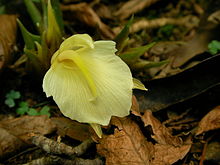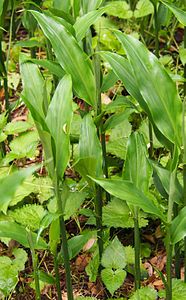bio.wikisort.org - Plant
Myoga, myoga ginger or Japanese ginger (myōga (茗荷)) is the species Zingiber mioga in the family Zingiberaceae. It is a deciduous herbaceous perennial native to Japan, China, and the southern part of Korea.[1][2][3] Only its edible flower buds and flavorful shoots are used in cooking.[4] The flower buds are finely shredded and used in Japanese cuisine as a garnish for miso soup, sunomono, and dishes such as roasted eggplant. In Korean cuisine, the flower buds are skewered alternately with pieces of meat and then are pan-fried.[citation needed]
| Myōga | |
|---|---|
 | |
| Scientific classification | |
| Kingdom: | Plantae |
| Clade: | Tracheophytes |
| Clade: | Angiosperms |
| Clade: | Monocots |
| Clade: | Commelinids |
| Order: | Zingiberales |
| Family: | Zingiberaceae |
| Genus: | Zingiber |
| Species: | Z. mioga |
| Binomial name | |
| Zingiber mioga | |
| Synonyms[1] | |
| |

Cultivation
A traditional crop in Japan, myoga ginger has been introduced to cultivation in Australia and New Zealand for export to the Japanese market.[3]
As a woodland plant, myoga has specific shade requirements for its growth. It is frost-tolerant to −16 °C (3 °F), and possibly colder.[3]
Three variegated cultivars are known: 'Dancing Crane', 'Silver Arrow' and 'White Feather'. They are less cold-hardy than unvariegated plants.[3]
Medicinal properties
Some constituents of myoga are cytotoxic[which?]; others have shown promise for potentially anticarcinogenic properties.[5]
Gallery
- Plants
- Fruits with red interiors and black seeds with a whitish aril
- Buds prepared for sale
References
- Kew World Checklist of Selected Plant Families
- Flora of China v 24 p 332, 蘘荷 rang he, Zingiber mioga (Thunberg) Roscoe, Trans. Linn. Soc. London, Bot. 8: 348. 1807.
- Cole TCH, Nürnberger S "Zingiber mioga and its Cultivars," The Plantsman. Royal Horticultural Society. December 2014, 4: 226-229.
- Matsuhisa, Nobu and Mark Edwards. (2007). Nobu West, p. 252.
- Ha Won Kim et al. "Suppressive Effects of Mioga Ginger and Ginger Constituents on Reactive Oxygen and Nitrogen Species Generation, and the Expression of Inducible Pro-Inflammatory Genes in Macrophages," Antioxidants & Redox Signaling. November/December 2005, 7(11-12): 1621-1629; retrieved 2013-8-4.
External links
- "Myoga" at 4seasonseeds.com.au
 Data related to Zingiber mioga at Wikispecies
Data related to Zingiber mioga at Wikispecies Media related to Zingiber mioga at Wikimedia Commons
Media related to Zingiber mioga at Wikimedia Commons
На других языках
- [en] Myoga
[es] Zingiber mioga
El myōga (茗荷, ''myōga''?) o jengibre myoga (Zingiber mioga) es una planta herbácea caducifolia originaria de Japón que se cultiva por los capullos comestibles de sus flores y sus sabrosos brotes. Los capullos se cortan en tiras finas y se usan en la cocina japonesa como guarnición para la sopa de miso, el sunomono y platos tales como la berenjena asada.Другой контент может иметь иную лицензию. Перед использованием материалов сайта WikiSort.org внимательно изучите правила лицензирования конкретных элементов наполнения сайта.
WikiSort.org - проект по пересортировке и дополнению контента Википедии


